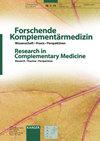Beobachtungsstudien im Rahmen eines naturheilkundlichen Klinikverbunds.
Q Medicine
引用次数: 2
Abstract
Objective: Empirical investigation of the influence of patient self-selection during follow-up in a prospective observational study in 4 in-patient facilities for complementary medicine and discussion of further methodological problems. Methods: 2662 patients treated in the 4 hospitals and included in a prospective observational study had been sent follow-up questionnaires 2, 6, and 12 months after admission. Characteristics and therapeutic success at discharge were compared in patients responding and those not responding. Results: Patients not responding to the follow-up questionnaires tended to be older and to assess the benefit of the treatment less positive than patients who responded (hospital one: 56.2% of patients with a follow-up reported a good or very good response to therapy at discharge compared to 37.7% of the patients without a follow-up: hospital two: 63.7% vs. 54.6%; hospital three: 71.1% vs. 65.8%; hospital four: 78,3% vs. 70,9%). Interpretation: When interpreting the results of the observational study a certain degree of bias induced by selection during follow-up has to be taken into account. Discussion: Other methodological problems discussed narratively include spontaneous improvements, reliability of baseline measures, influence of effective cointerventions, side-effects, outcome measures, feasibility, and efficiency. Finally, recommendations for quality management programs in in-patient facilities for complementary medicine are provided.一个自然治愈性诊所进行的观察研究
本文章由计算机程序翻译,如有差异,请以英文原文为准。
求助全文
约1分钟内获得全文
求助全文

 求助内容:
求助内容: 应助结果提醒方式:
应助结果提醒方式:


